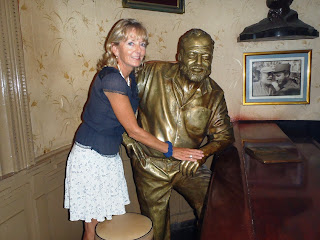Another tempestuous crossing from Mexico,
across the Yucatan Channel, racing against the coming coldfront, and we finally
doused our sails in Hemingway Marina, Cuba. The 'Old Man of the Sea' wrote
several novels here in the 1930's, including Islands in the Stream, about his
beloved Cuba. With our old friend Turlough aboard as crew, we set off to
explore this baffling land of contradictions.
Fifty years of
Socialism under Fidel, and the U.S. embargo, has created an isolated island
nation stuck in a 1950's time warp. The once elegant streets of Havana are
fringed with stately, pastel-coloured manor houses, slowly mouldering away, and
concrete tenament housing for the masses. Salsa and Jazz music drift into the
cobblestone streets late into the night. Old mid-century American cars
(Macinas); Chevy Impala's and Buick's, repainted in graphic colours, line
the roadways.
Our first stop is La Floridita Bar, where Papa Hemingway's bronze statue still holds a sacred spot. With the double currencies of the Cuban Peso, generally for the locals, and the C.U.C. or Convertible Dollar, mainly set up for the tourist trade and luxury items (like say, toothpaste or moisturizer), it is difficult to get a handle on how this complex economy actually works. The Cubans also get ration coupons from the government to buy basic necessities. This tends to mean standing in long lineups for chicken or a tin of peanut butter in shops that have mostly empty shelves. But the people are patient and cheerful and spend their time chatting in the queue or arranging their next crafty business deal.
Another Cuban anachronism is the ongoing
fascination with revered son of La Revolucion, Che Guevara. The face of the
ruggedly handsome guerrillero adorns building facades, museums and T-shirt
shops throughout the island. The legend of Che and Fidel's dramatic siege on
Batista's cruel regime has won the hearts and minds of this most patriotic of
peoples.
But Cuba quickly seeps under your skin.
We took an inland trip through the rural campos (countryside) and toured
the dusty, French-provincial, mausoleum-like towns of Cienfuegos, and Santa
Clara shrine to the ubiquitous Che'. It was like a step back in time to watch
the horse and buggies quietly clomping along the cobblestone avenues.
Trinidad, the gem of the island, is a
perfectly preserved Spanish Colonial settlement where the clocks stopped
ticking in 1850. Built on the wealth of the sugarcane plantations and the grim
slave trade, the town is laden with fine carved furniture, cut glass, and
candelabras of times past.
We hooked up with two lovely Aussie's and rode our bikes to the beautiful beaches of Playa Ancon on the coast.
We hooked up with two lovely Aussie's and rode our bikes to the beautiful beaches of Playa Ancon on the coast.
 |
| Our Aussie travelling friends, Carolina and Cam |

On our trip home we are amazed to find the six lane highway, built by the Russians during the Cold War, virtually empty of traffic except for a few trucks and tour buses, and the odd horse and carriage ambling along. A vision of an L.A. freeway flits across my mind, and I wonder once again if perhaps there is another, simpler world out there? Time to stop and smell the coffee.
 | |
| Playa Ancon |
 |
| Elisa, Coo-kie and Cathy at Salsa Night |


























